Connect With Us
Blog
Items filtered by date: July 2024
Stretches Can Help the Feet
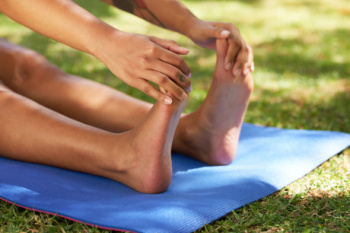
Standing for prolonged periods of time can cause aches and pains in your feet and lower limbs. In addition to wearing comfortable shoes and taking breaks to sit and walk around, one other way that you can prevent or relieve pain is to stretch. A lunging calf stretch can help prevent cramping in the calf muscles, plantar fasciitis, and other foot problems. It can also promote circulation. To do this stretch, stand one step away from a wall and place both palms flat against it. Step your left foot back and bend your right knee into a lunge. Keep your toes pointing forward and slowly push your left heel toward the ground until you feel a stretch in your calf. Hold and then repeat on the opposite foot. To learn more about the benefits of stretching your feet, it’s suggested that you consult with a podiatrist.
Stretching the feet is a great way to prevent injuries. If you have any concerns with your feet consult with one of our podiatrists from Palm Beach Foot & Ankle. Our doctors will assess your condition and provide you with quality foot and ankle treatment.
Stretching the Feet
Stretching the muscles in the foot is an important part in any physical activity. Feet that are tight can lead to less flexibility and make you more prone to injury. One of the most common forms of foot pain, plantar fasciitis, can be stretched out to help ease the pain. Stretching can not only ease pain from plantar fasciitis but also prevent it as well. However, it is important to see a podiatrist first if stretching is right for you. Podiatrists can also recommend other ways to stretch your feet. Once you know whether stretching is right for you, here are some excellent stretches you can do.
- Using a foam roller or any cylindrical object (a water bottle or soda can will do), roll the object under your foot back and forth. You should also exert pressure on the object. Be sure to do this to both feet for a minute. Do this exercise three times each.
- Similar to the previous one, take a ball, such as a tennis ball, and roll it under your foot while seated and exert pressure on it.
- Grab a resistance band or towel and take a seat. If you are using a towel, fold it length wise. Next put either one between the ball of your foot and heel and pull with both hands on each side towards you. Hold this for 15 seconds and then switch feet. Do this three times for each foot.
- Finally hold your big toe while crossing one leg over the other. Pull the toe towards you and hold for 15 seconds. Once again do this three times per foot.
It is best to go easy when first stretching your foot and work your way up. If your foot starts hurting, stop exercising and ice and rest the foot. It is advised to then see a podiatrist for help.
If you have any questions, please feel free to contact our offices located in Boynton Beach, Palm Beach Gardens, and West Palm Beach, FL . We offer the newest diagnostic and treatment technologies for all your foot care needs.
Footwear and Its Impact on Gout Patients
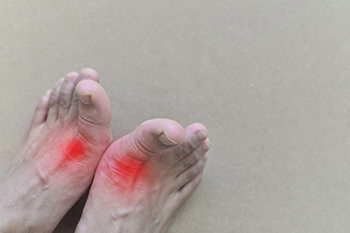 Gout, an inflammatory arthritic condition caused by the crystallization of uric acid in joints, often results in severe pain and swelling in the big toe. Recent research underscores the significant impact that footwear choices can have on individuals suffering from gout. Findings show that wearing improper footwear, such as sandals, flip-flops, and slippers, can lead to heightened foot pain, impairment, and disability. Notably, poor shoes often lacked proper cushioning, support, and stability, contributing to increased discomfort and functional impairment. In addition, shoes that were 12 months or older and showed excessive wear patterns are factors. For that reason, it is essential for gout sufferers to carefully choose footwear that offers ample cushioning, proper support, and stability to alleviate foot pain and improve function. A podiatrist can diagnose gout, prescribe medication, and offer advice on selecting the right shoes to manage gout symptoms. If you are suffering from the flare-ups of gout, it is suggested that you schedule an appointment with a podiatrist for an exam, diagnosis, and treatment options.
Gout, an inflammatory arthritic condition caused by the crystallization of uric acid in joints, often results in severe pain and swelling in the big toe. Recent research underscores the significant impact that footwear choices can have on individuals suffering from gout. Findings show that wearing improper footwear, such as sandals, flip-flops, and slippers, can lead to heightened foot pain, impairment, and disability. Notably, poor shoes often lacked proper cushioning, support, and stability, contributing to increased discomfort and functional impairment. In addition, shoes that were 12 months or older and showed excessive wear patterns are factors. For that reason, it is essential for gout sufferers to carefully choose footwear that offers ample cushioning, proper support, and stability to alleviate foot pain and improve function. A podiatrist can diagnose gout, prescribe medication, and offer advice on selecting the right shoes to manage gout symptoms. If you are suffering from the flare-ups of gout, it is suggested that you schedule an appointment with a podiatrist for an exam, diagnosis, and treatment options.
Gout is a foot condition that requires certain treatment and care. If you are seeking treatment, contact one of our podiatrists from Palm Beach Foot & Ankle. Our doctors will treat your foot and ankle needs.
What Is Gout?
Gout is a type of arthritis caused by a buildup of uric acid in the bloodstream. It often develops in the foot, especially the big toe area, although it can manifest in other parts of the body as well. Gout can make walking and standing very painful and is especially common in diabetics and the obese.
People typically get gout because of a poor diet. Genetic predisposition is also a factor. The children of parents who have had gout frequently have a chance of developing it themselves.
Gout can easily be identified by redness and inflammation of the big toe and the surrounding areas of the foot. Other symptoms include extreme fatigue, joint pain, and running high fevers. Sometimes corticosteroid drugs can be prescribed to treat gout, but the best way to combat this disease is to get more exercise and eat a better diet.
If you have any questions please feel free to contact our offices located in Boynton Beach, Palm Beach Gardens, and West Palm Beach, FL . We offer the newest diagnostic and treatment technologies for all your foot and ankle needs.
Wounds That Don't Heal Need to Be Checked
What Is Morton’s Neuroma?
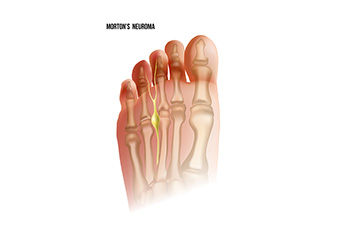
Morton's neuroma is a painful condition affecting the ball of the foot, resulting from a thickening of tissue around a nerve, often between the third and fourth toes. Symptoms include a burning sensation, tingling, or numbness in the affected area, along with the feeling of a small pebble or lump underfoot. Pain may worsen with activity or wearing tight shoes. Treatment options for Morton's neuroma focus on relieving pressure on the affected nerve. This includes wearing shoes with a wider toe box or adding padding to support the arch and alleviate pressure. Avoiding activities that worsen symptoms also helps. Podiatrists may recommend corticosteroid injections to reduce inflammation, or in severe cases, surgical removal of the neuroma. Early intervention ensures effective management, relieving discomfort and restoring foot function. Visiting a podiatrist is suggested for a precise diagnosis and personalized treatment plan.
Morton’s neuroma is a very uncomfortable condition to live with. If you think you have Morton’s neuroma, contact one of our podiatrists of Palm Beach Foot & Ankle. Our doctors will attend to all of your foot care needs and answer any of your related questions.
Morton’s Neuroma
Morton's neuroma is a painful foot condition that commonly affects the areas between the second and third or third and fourth toe, although other areas of the foot are also susceptible. Morton’s neuroma is caused by an inflamed nerve in the foot that is being squeezed and aggravated by surrounding bones.
What Increases the Chances of Having Morton’s Neuroma?
- Ill-fitting high heels or shoes that add pressure to the toe or foot
- Jogging, running or any sport that involves constant impact to the foot
- Flat feet, bunions, and any other foot deformities
Morton’s neuroma is a very treatable condition. Orthotics and shoe inserts can often be used to alleviate the pain on the forefront of the feet. In more severe cases, corticosteroids can also be prescribed. In order to figure out the best treatment for your neuroma, it’s recommended to seek the care of a podiatrist who can diagnose your condition and provide different treatment options.
If you have any questions, please feel free to contact our offices located in Boynton Beach, Palm Beach Gardens, and West Palm Beach, FL . We offer the newest diagnostic and treatment technologies for all your foot care needs.
Symptoms of a Sprained Ankle
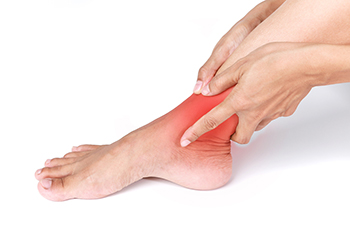 A sprained ankle occurs when the ligaments that support the ankle stretch or tear due to sudden twisting, rolling, or turning of the foot. This injury is common in sports, walking on uneven surfaces, or missteps that put the ankle in an awkward position. Symptoms of a sprained ankle can include pain, swelling, bruising, and difficulty bearing weight on the affected foot. You might also hear a popping sound at the time of the injury. To determine if you have a sprain, pay attention to the severity of pain and swelling, any instability in the ankle, and whether the pain worsens with movement. Initial treatment for a sprained ankle involves rest, compression, and elevation. Avoid putting weight on the ankle and consider using crutches. Anti-inflammatory pain relievers can help manage pain and discomfort. Proper rehabilitation, including targeted stretching exercises, is essential for healing and preventing future injuries. If you think you have sprained your ankle, it is suggested that you schedule an appointment with a podiatrist for an accurate diagnosis and comprehensive treatment plan.
A sprained ankle occurs when the ligaments that support the ankle stretch or tear due to sudden twisting, rolling, or turning of the foot. This injury is common in sports, walking on uneven surfaces, or missteps that put the ankle in an awkward position. Symptoms of a sprained ankle can include pain, swelling, bruising, and difficulty bearing weight on the affected foot. You might also hear a popping sound at the time of the injury. To determine if you have a sprain, pay attention to the severity of pain and swelling, any instability in the ankle, and whether the pain worsens with movement. Initial treatment for a sprained ankle involves rest, compression, and elevation. Avoid putting weight on the ankle and consider using crutches. Anti-inflammatory pain relievers can help manage pain and discomfort. Proper rehabilitation, including targeted stretching exercises, is essential for healing and preventing future injuries. If you think you have sprained your ankle, it is suggested that you schedule an appointment with a podiatrist for an accurate diagnosis and comprehensive treatment plan.
Ankle and foot injuries are common among athletes and in many sports. They can be caused by several problems and may be potentially serious. If you are feeling pain or think you were injured in a sporting event or when exercising, consult with one of our podiatrists from Palm Beach Foot & Ankle. Our doctors will assess your condition and provide you with quality foot and ankle treatment.
Common Injuries
The most common injuries that occur in sporting activities include:
- Achilles Tendonitis
- Achilles Tendon Rupture
- Ankle Sprains
- Broken Foot
- Plantar Fasciitis
- Stress Fractures
- Turf Toe
Symptoms
Symptoms vary depending upon the injury and in some cases, there may be no symptoms at all. However, in most cases, some form of symptom is experienced. Pain, aching, burning, bruising, tenderness, tightness or stiffness, sensation loss, difficulty moving, and swelling are the most common symptoms.
Treatment
Just as symptoms vary depending upon the injury, so do treatment options. A common treatment method is known as the RICE method. This method involves rest, applying ice, compression and elevating the afflicted foot or ankle. If the injury appears to be more serious, surgery might be required, such as arthroscopic or reconstructive surgery. Lastly, rehabilitation or therapy might be needed to gain full functionality in the afflicted area. Any discomfort experienced by an athlete must be evaluated by a licensed, reputable medical professional.
If you have any questions, please feel free to contact our offices located in Boynton Beach, Palm Beach Gardens, and West Palm Beach, FL . We offer the newest diagnostic and treatment technologies for all your foot care needs.
Foot and Ankle Pain From Wearing High Heels
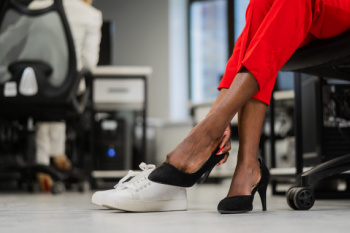
Wearing high heels can be fashionable, but they often come with the price of foot and ankle pain. The design of high heels forces the foot into an unnatural position, placing excessive pressure on the ball of the foot and causing the toes to be cramped together. This can lead to a range of issues, including blisters, calluses, bunions, and hammertoes. The elevated heel also alters the body's alignment, putting additional strain on the ankles, knees, and lower back. High heels can also contribute to developing plantar fasciitis, where the ligament running along the bottom of the foot becomes inflamed and painful. Ankle sprains are more likely due to the instability caused by the narrow heel base. To minimize these risks, it is important to choose high heels with proper support and cushioning, limit the time spent wearing them, and perform regular foot stretches and exercises to maintain flexibility and strength. If you experience foot or ankle pain after wearing high heels, it is suggested that you schedule an appointment with a podiatrist for an exam and treatment.
High heels have a history of causing foot and ankle problems. If you have any concerns about your feet or ankles, contact one of our podiatrists from Palm Beach Foot & Ankle. Our doctors can provide the care you need to keep you pain-free and on your feet.
Effects of High Heels on the Feet
High heels are popular shoes among women because of their many styles and societal appeal. Despite this, high heels can still cause many health problems if worn too frequently.
Which Parts of My Body Will Be Affected by High Heels?
- Ankle Joints
- Achilles Tendon – May shorten and stiffen with prolonged wear
- Balls of the Feet
- Knees – Heels cause the knees to bend constantly, creating stress on them
- Back – They decrease the spine’s ability to absorb shock, which may lead to back pain. The vertebrae of the lower back may compress.
What Kinds of Foot Problems Can Develop from Wearing High Heels?
- Corns
- Calluses
- Hammertoe
- Bunions
- Morton’s Neuroma
- Plantar Fasciitis
How Can I Still Wear High Heels and Maintain Foot Health?
If you want to wear high heeled shoes, make sure that you are not wearing them every day, as this will help prevent long term physical problems. Try wearing thicker heels as opposed to stilettos to distribute weight more evenly across the feet. Always make sure you are wearing the proper shoes for the right occasion, such as sneakers for exercising. If you walk to work, try carrying your heels with you and changing into them once you arrive at work. Adding inserts to your heels can help cushion your feet and absorb shock. Full foot inserts or metatarsal pads are available.
If you have any questions please feel free to contact our offices located in Boynton Beach, Palm Beach Gardens, and West Palm Beach, FL . We offer the newest diagnostic and treatment technologies for all your foot and ankle needs.

